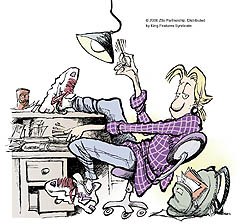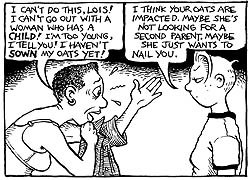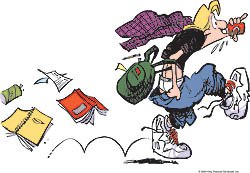Comic strips have been adapted into animation since the art form's origins. This month Dr. Toon looks at some of today's leading contenders to make the leap to motion.

Jeremy Duncan is the central character of Zits, which chronicles the complexities of modern family life. © 2002 Zits Partnership. Published online by permission of King Features Syndicate.
The printed comic strip and animated cartoons have shared a long mutual history; in many cases, the former has given birth to the latter. Newspaper magnate William Randolph Hearst even established his own studio for the purpose of having his newspaper strips animated, the better to boost circulation. So it was in the halcyon days of rice paper and India ink when Mutt and Jeff, Krazy Kat, and The Katzenjammer Kids displayed their stiff and jerky charms beneath crude word balloons. In some cases, things got better as time went on, as demonstrated by Fleischer studio's Popeye The Sailor series. Bill Melendez also did a terrific job of bringing Charles Schultz' Peanuts strip to life, putting Charlie Brown and crew into some of the niftiest cartoon specials of the 1960s and '70s.
In some cases, the formula failed: Columbia's mangling of Al Capp's Li'l Abner strip in 1944 is a prime example. A sad end also came to Filmation's Fabulous Funnies in 1979 when audiences failed to respond to animated versions of Broomhilda, Alley Oop and other luminaries of the comic strip trade. The tradition continued on into the 1980s with some success, most notably in adaptations of Jim Davis' Garfield, George Gately's Heathcliff and Pierre Culliford's Les Schtroumpfs (that's The Smurfs to the Saturday Morning crowd). A more recent example of strip-to-screen would be that scarred survivor of the Great Millennial Prime-Time Slaughter, Jerry Scott's Baby Blues. In many cases a feedback loop occurred between the comics and animation so that Felix the Cat and Mickey Mouse, among others, made the transition to a daily strip.
This rich and productive cross-pollination between print and animation mediums is one of the forces that keeps animation vital, and hopefully it will continue on into the future. Actually, I predict that we will see more of these transitions from strip to screen on a regular basis, since one of the great trends of the past decade is the conglomeration and merger of media companies. Comic strips, being a presold commodity, can gain a second round of profits in animated form. This represents an economic windfall that will become increasingly irresistible to entertainment moguls, cartoonists and animation studios alike. Presold commodities are also more likely to find funding than original products; buyers and distributors may feel safer laying their ducats on animating a comic strip that runs in 900 newspapers and reaches a readership of millions than an original idea by a gang of recent graduates from Animation U. Not to mind whose idea may be better; that, dear readers, just isn't the point.
So...what's out there these days that might carry on the grand old tradition? Which recent comic strips might take their place in the hallowed pantheon of media jumpers? Allow me, if you will, to tease you with some contenders. These are not capricious selections by any means; these first two were chosen with an eye to the question that endlessly nags American animation to this day: "When are we going to see some animation for adults?" Well, suppose the answer to this question isn't to be found in American animation as it exists today? What if a cross-influence from another medium is needed in order for this process to make a quantum leap? What if I quit hypothesizing and simply get to my picks?

A top Goodman pick for transition to the screen is The Boondocks by Aaron McGruder. © Aaron McGruder. Reprinted with permission of uclick. All rights reserved.
The Boondocks
My initial offering is all the more exciting because it may actually happen (one of these days). The strip is The Boondocks, and the cartoonist is Aaron McGruder. For a strip that has only existed since 1997, Boondocks has managed to become one of the most controversial comics of its day. The strip explores the lives of several young African-American children who have relocated from the ghetto to the mostly white suburb of Woodcrest, U.S.A. The main protagonist is Huey Freeman. Despite his years he is somewhat of a scholar, constantly reading and questioning the world around him. Consumed with a preternatural rage, this unsmiling youth serves as McGruder's voice as he examines the hypocrisies inherent in both white -- and black -- society. His younger brother Riley refuses to relinquish the gangsta culture of the old 'hood and wields a clutch of dangerous-looking squirt guns. The pair are befriended by Michael Caesar, hip-hoppin' MC and budding lyricist, and Hiro Otomo, the self-proclaimed master of "turntable bushido." Rounding out the main cast are Grandad, caretaker to Huey and Riley, and sweet-natured Jazmine DuBois. The latter is a bewildered biracial young girl who serves as a foil to Huey's sulkiness. Jazmine also functions as a living exploration of the similarities and contradictions between the races.
Not all readers respond positively to the strip; this is mainly because Mr. McGruder speaks his mind openly and unsparingly, swayed neither by the trap of political correctness nor any perceived obligation to ignore the contradictions in his own culture. McGruder is equally impatient with readers of either race when they miss the satire in Boondocks or assume that he is speaking for every character. Shortly after appearing on several programs airing on Black Entertainment Television, McGruder blasted the network in several strips for trivializing blacks and perpetuating repugnant stereotypes while purporting to be black America's entertainment network. BET claimed that McGruder was embittered by his failure to sell an animated Boondocks project to the network, a charge McGruder denies. At last report (or rumor), McGruder was making a deal with an unnamed cable network and had hired Reginald Hudlin to direct. We shall see.
This strip has everything it needs to be a great animated series with adult sensibilities. McGruder's pull-no-punches style and blunt willingness to confront the thorniest issues facing blacks and whites in this era mixes nicely with his dictum that we have left our children these questions; they will have to wrestle with them using their own sensibilities. McGruder's artistic style is moody, with muted colors predominant. His characters tend to be low-slung, angular and sharply edged; they should animate quite well. Since McGruder mostly works with children, animators had best be prepared to work 2 1/2 heads high. Due to the nature of the dialogue, it might be better to cast adults as voice actors and have them intone "younger" voices; Boondocks would not work with cutie-pie warbling. If the rumors are true, we may possibly see the animated version in late 2002. If not, somebody...please...make a deal with Aaron McGruder. This show belongs on television.

Sophisticated and sharp, Alison Bechdel's Dykes to Watch Out For is another contender to go from paper to television. © Alison Bechdel.
Dykes To Watch Out For
Even those who are not members of the gay community can find plenty to laugh about in Alison Bechdel's raucous comic strip Dykes To Watch Out For. This well-kept secret would make a terrific coup for some progressive cable network willing to foot the bill. Dykes has been running since 1983 and can be found in nearly seventy magazines, not all of them gay publications; readers of the Funny Times are no doubt familiar with this comic (also available on the Web). In that nineteen-year span, Bechdel has built up a community of endearing characters who are sharp, thoughtful, politically aware and never stop coming to grips with life. Mo is an active feminist and resident socialist whose rants and diatribes often fall on uncomprehending ears. Lois is a self-confident, flip mistress of sarcasm. Clarice, a prominent attorney, lives on an ever-changing diet of antidepressants while her lifemate Toni tries to keep up with their son (yup, that's right), Raffi. Sydney and Ginger are fixtures at the local university, where the former is forever fighting for tenure while the latter has spent half her life trying to graduate from a Doctoral program. Matronly Jezanna runs the chaotic "Madwimmen Bookstore" where we often find dreamy Sparrow, a New Age astrology freak.
This strip contains as much adult humor and political satire as Doonesbury, and not all of it involves lesbianism (though the humor takes place inside that general context). The strip has a quirky feel; the same newspaper might change its headlines from one panel to the next, or a TV playing in the background might play counterpoint to the dialogue. As one might have guessed by now, the strip's politics are quite liberal, but at times Bechdel will pull an ideological surprise in order to enhance the satire or make a mordant point or two. Dykes is deceptively sophisticated but this is best discovered by reading a series of episodes rather than taking any one strip at random, and that fact alone makes it good material for an animated series.
Still, Dykes greatest strength is its sizable cast of funny, expressive characters and the relationships that lie at the heart of the story. Given time to develop, this could be every bit as interesting as King of the Hill, with the difference that the humor is decidedly more adult. Bechdel has identified Robert Crumb as a major artistic influence; this is obvious in the strip, especially in the drawing of facial expressions. Bechdel's line, however, is cleaner, her proportions better and her poses less exaggerated than Crumb's. Animating this show would call for good reproduction of the human figure. Backgrounds may have to be simplified as Bechdel sometimes crowds her panels; this might not work on television, where her animated characters would have to register more strongly on the screen. Who wants to take a chance on this one? MTV? HBO? How about TNN putting this one into their new "adult" animation slot? Dykes To Watch Out For is one comic strip we should watch out for on TV. Perhaps some day we will.
OK, those are my two main proposals. Here are a couple of more mainstream possibilities that would at least make for a decent Christmas special (What? Another one?). These strips adhere less to meeting criteria for "adult" animation, but we can't expect the industry to change overnight. As mentioned earlier, Jerry Scott made it to TV with an adaptation of Baby Blues, but in fact he is also the co-author of a much better strip. Zits was conceived by Scott and Pulitzer Prize winning cartoonist Jim Borgman in 1997; today the strip is carried by nearly 900 newspapers. The main protagonist appears to be 15 year-old Jeremy Duncan, but the strip is actually the chronicle of a generation gap, new millennium style. Jeremy's confounded parents are Walt and Connie Duncan, and the strip is often portrayed from their point of view. Because Zits takes this approach, there tends to be an emotional range and complexity that reflects true family life. In one strip, Jeremy may be startlingly insensitive while ridiculing his father; in the next, they may share high-fives after mischievously teaming up on Mom.

Jerry Scott and Jim Borgman, the creators of Zits, capture youth's exuberance and surliness. © 2002 Zits Partnership. Published online by permission of King Features Syndicate.
The strip is a good candidate for animation because the narrative is generally episodic, with storylines running for a week or longer. Scott and Borgman have generated enough characters (mostly Jeremy's teenage cohorts) to carry a series. Borgman is especially good at capturing adolescent surliness, postures and emotional angst. Scott is an observant writer whose teenagers ring remarkably true; one would guess that the dialogue was provided by high school students -- zits and all -- while Scott transcribed their words. Borgman's style in this strip runs to caricature rather than realism; his line is easy and relaxed with few cluttering details. Sometimes one can find surrealism and morphing in the panels, an added plus for animation. This strip would pose no particular problem for most animators, and its shifting perspective between teens and adults would appeal to a broad range of the market. Zits would make for a more sophisticated series than comparable "tween" shows such as Pepper Ann or Doug, and thus I place it in my "second tier."

In Mutts, Patrick McDonnell tips his hat to the style of George Harriman. © 2002 Patrick McDonnell. Published online by permission of King Features Syndicate.
And now just for fun: Why not take things full circle to the days of animation's seminal stars? Patrick McDonnell started his strip Mutts in 1994 and since then has won several international awards. The cartoonist has also been nominated four times for the prestigious Reuben Award and took it home in 1998. Of particular interest: McDonnell is the author of Krazy Kat: The Art of George Harriman. McDonnell has virtually recreated that renowned cartoonist's élan in Mutts, a funny animal strip that counted the late Charles Schultz among its biggest fans. Mooch the cat and Earl the dog are the four-pawed philosophers of this strip, switching from this profession to more typical animal behavior within a panel or two.
The word "charming" best describes Mutts, which is executed in the drawing style of Harriman. McDonnell's characters do have a slightly wider range of expression and display more active poses than Harriman's, whose animals were more similar to Delsarte actors. Another variant of Harriman's humor is Mooch's vocal peculiarity: "S" is pronounced as "sh" (Yesh, thish ish funny). Because there are no continuing storylines and a relatively small cast of characters, Mutts may make a better one-shot special than series. Animators are strongly advised to study Harriman, but should have little difficulty with McDonnell's loosely-drawn characters.
There may be better choices than the ones presented here and I am certain that many of you have your own candidates, but that is exactly the point: the comics will forever be a spawning ground for great animation, and not always at Yuletide. Be they hip-hoppers, dykes, teens, mutts, or whoever is gracing the strips these days, bring 'em on; ink and paint in one medium can be just as entertaining in another.
Martin "Dr. Toon" Goodman is a longtime student and fan of animation. He lives in Anderson, Indiana.







